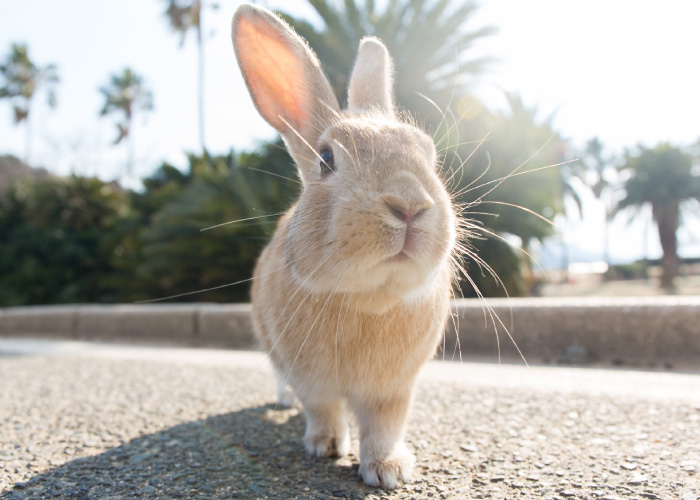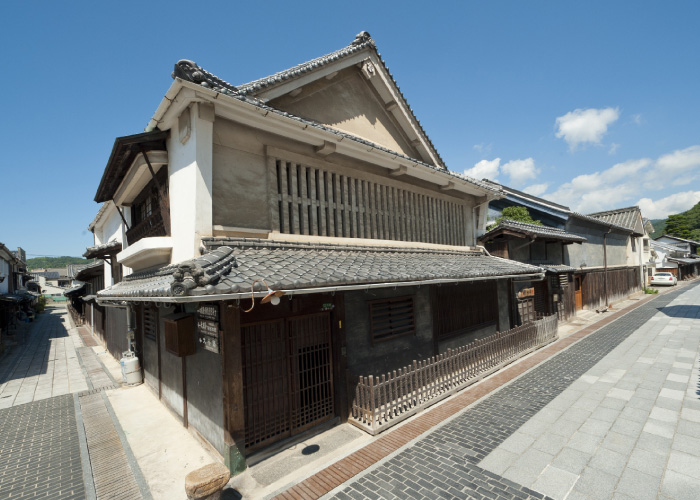



Ohkunoshima is an island in the Seto Inland Sea off of the coast of Tadanoumi Port. It is the only place in the world where visitors can wander freely among wild rabbits. Originally there were only a few rabbits on the island, but over the years, the number of rabbits has increased to over 900. In recent years, Ohkunoshima has become one of the most popular tourist destinations in Hiroshima prefecture, attracting visitors from around the world. Last year over 300,000 people visited the island. We recommend that you stay overnight on the island at the Kyukamura Hotel to enjoy spending time among the rabbits because are especially active in the morning and evening.
The best way to get to Ohkunoshima from the UNESCO World Heritage Sites of the Atomic Bomb Dome and Miyajima in Hiroshima City is to take a highway bus from Hiroshima’s main train station going directly to the Tadanoumi Station, and walk to Tadanoumi Port.
Rabbit-related items and rabbit food, as well as ice cream and coffee, are available for purchase at a shop at Tadanoumi Port.
*You can also buy rabbit-related items at a convenience store and supermarket at Tadanoumi Port. It is a good idea to have rabbit food with you when you arrive at Ohkunoshima as many bunnies will greet you as soon as you arrive on the island!
Please use the Hotel Kyukamura Ohkunoshima for your meals and accommodation.
While it is easy to tour Ohkunoshima on foot, there is a free bus service that connects the island’s ferry terminal, Ohkunoshima pier, and Kyukamura Ohkunoshima Hotel to help you get around. Bicycles are available for rent at Kyukamura Ohkunoshima Hotel.
Known today as “Rabbit Island”, Ohkunoshima has a dark history when it was the site of facilities for the Imperial Japanese Army during the first half of the 19th century. Erased from maps of the time because of the classified nature of its activities, Ohkunoshima was the location of a military fortress during the Russo-Japanese War of 1905, factories that made poison gas during World War II, and an ammunition depot during the Korean War. Today the ruins of these facilities, covered with ivy and weathered by time, wind, and rain, sit silently as fascinating markers of these turbulent times. Most visitors to the island are unaware of these sites until they arrive on Ohkunoshima, and it is thanks to the popularity of “Rabbit Island” that the island’s tragic history can be told.
Takehara has a 350-year history, spanning a period when the its merchants were leading makers of salt and sake in Japan. Today you can see their old houses as well as the many public buildings erected with the town’s wealth, including old shrines and temples. Take a relaxing stroll through Takehara and enjoy a walk through time.
The easiest access from the World Heritage sites in Hiroshima city, such as the Atomic Bomb Dome and Miyajima, is to a take highway bus from Hiroshima Station directly to Takehara Station. It takes about 12 minutes from Takehara Station to the townscape preservation area by foot.
Hiroshima Station → (Highway Bus Kaguyahime-go, About 90 minutes) → Takehara Station → (About 12 minute walk) → Townscape Preservation Area
Miyajima → (JR Miyajima Ferry, 10 minutes, 1km) → Miyajimaguchi Station → (Bound for Hiroshima on JR Sanyohonsen, About 30 minutes, 22 km) → Hiroshima Station (See "From Hiroshima Station” above.)
Ohkunoshima Pier → (Kyukamura Kyakusen or Omishima Ferry, About 15 minutes) → Tadanoumi Port → (7 minute walk) → Tadanoumi Station → (Bound for Hiroshima on JR Kure Line, About 15 minutes, 8km) → Takehara Station → (About 12 minute walk) → Townscape Preservation Area
There are signs of local customs everywhere along the 350-year old streets of Takehara. Many people living in the town continue ancient traditions, and the residents decorate the front of their houses with flowers to welcome visitors and demonstrate their hospitality.
Each house has its own unique lattice covering its windows. Called “Takehara Lattice”, the variety of designs include panel lattice that looks like art cut from paper and transverse lattice with many interesting patterns. Why don’t you enjoy a stroll through the town to look at such beautiful lattice?
Located on the side of the hill behind the historic district, Fumeikaku at Saihoji Temple is a popular sightseeing spot. From its platform there is an amazing view of Takehara. The stone staircase leading to the temple is often used as a location for shooting movies.
Learn how to make a bamboo basket by weaving together individual bamboo sticks. With instruction from the friendly staff, even beginners can make baskets with ease. bamboo crafts are displayed and sold in the workshop.
The museum is a renovated section of a former sake brewery built at the end of the Edo period. With over 130 years of history and tradition, it is an impressive building with thick columns and rafters running along the ceiling, as well as a lingering aroma of Japanese sake. They offer sake tasting on-site and the opportunity to brew your own personalized sake. They sell pottery, bamboo products, bamboo charcoal coffee, Japanese paper made from bamboo, and other bamboo-themed foods and products. You can also enjoy delicious handmade soba noodles and sake at the Tanizaki restaurant.
Yusaka Onsen is also called “Tsuru no Yu”. According to legend, a wounded tsuru(crane) was cured by drinking its hot spring waters. This good quality, mildly radioactive cold mineral spring is great for treating neuralgia, joint pain, and other afflictions,Both hotels offer day trip plans.